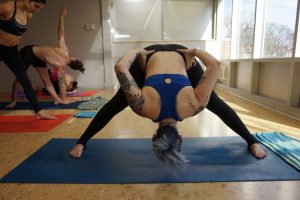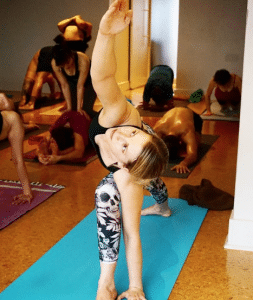I’m not going to lie, for the first year or so of practice, I didn’t think much of the fundamental asanas.
To me, the standing sequence was just something I had to “get through” until the real practice started. I spent a lot of time rushing through it, and not really focusing on my alignment because, at the time, it seemed like just a warm-up.
And if I’m being totally honest, for a while I was unclear of the correct vinyasa for each fundamental posture.
I mean, I got the jist of it, but I spent a lot of time in Hasta Padangusthasana thinking, “Is it inhale head up only, or do I lift my chest a little? Do I exhale with my head still lifted, or do I exhale to fold? Where do my arms go? What am I going to eat for breakfast?”
Oh, the mental drama! All in one pretty basic pose.

My lack of clarity around these standing postures made it easier for my mind to wander, which set the stage for a very distracted practice.
But over the years, and under the guidance of my teacher, I’ve come to realize that focusing on, and perfecting the fundamental asanas is so important.
First of all, they are called fundamental for a reason. The movements that we learn in these postures are fundamental to our understanding of how to perform more advanced asana correctly. We need to learn to walk before we can run. And the fundamental asanas afford us the opportunity to understand the basic’s of a movement before we go deeper.
The wisdom of Ashtanga, however, goes far beyond the physical asana, and into what adhering to the correct vinyasa gives us.
Self-proclaimed vinyasa geek and Level 2 authorized teacher David Robson says,
“The essence of the practice is in using the external, objective structure of the tradition to provide the boundaries of focus. We then watch what transpires within these boundaries to learn about the nature of the mind, and ultimately, the Self.”

What I didn’t know then, that I know now, is how important the structure of this practice is.
When you don’t have to think about what to do next – when it is literally spelled out for you – where to look, what to do, how to freakin’ breathe, the mind has nothing left to do, other than simply be.
It’s kinda of scary when I say it out loud, or in this case, write it down. Because, if I’m not thinking, who am I then?!
…the one who sees the thinking.
It is only when we create the space for ourselves to be free from thinking about what’s next, that we have the opportunity to watch the mind and see who we truly are.
So how do we do this? How do we create that space?
We get super clear on the correct vinyasa for each and every pose, and we focus on that throughout our practice. Every. Single. Day. This takes time, and practice, and a willingness to learn and understand these postures.
If you want to learn more, David and Jelena have just released a new video called “Perfecting the Fundamental Asana’s.” They break down the fundamental asanas, delve into the wisdom of the structure of Ashtanga Yoga, and so much more. You really don’t want to miss this!
How do you feel about the fundamental asanas? Are you clear on the count, or does your mind constantly wonder if you’re doing it right (like the old Mel)?! Let us know in the comments below!

It wasn’t until I started learning the count that I really started to enjoy these postures way more! I love the comment about how scripted the series can be… “where to look, what to do, how to freakin breathe”… Sometimes I think why do I keep doing this if there is nothing “new”, all that I do is laid out in front of me, but thats the real good part of it 🙂 Thanks for the blogs as always!
So glad you enjoyed it! We will keep em’ comin!